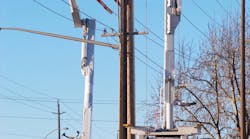Batteries wear out, just like any other replacement part. But because weak batteries aren't as noticeable as balding tires or squeaky brakes, they are usually replaced only after they fail, notes Vicki A. Hunckler, marketing communications manager for Midtronics (www.midtronics.com/transportation), a worldwide leader and provider of vehicle battery testing and management products and services. This creates inconvenience and possibly dangerous situations on the road for drivers, not to mention negatively impacting fleet operations by sidelining vehicles and delaying shipments/operations.
With proper care and maintenance, an initial investment in deep-cycle flooded, AGM (Absorption Glass Mat) or gel battery technology can be extended, keeping the total cost of ownership to a minimum, points out Brad Bisaillon, director of strategic accounts for North America and Europe for Trojan Battery Company (www.trojanbattery.com), the world's leading manufacturer of deep-cycle batteries. Following seven simple steps will ensure that these batteries will enable optimum equipment operation levels day in and day out.
1. Safety
- Always wear protective clothing, safety glasses and gloves.
- Never add acid to a battery.
- Keep batteries clean and dry.
- Keep sparks, flames and cigarettes away from batteries.
- Charge batteries only in well ventilated areas.
- Avoid skin contact with electrolyte.
- Always use insulated tools.
2. Watering (flooded batteries only)
- Add water only after fully charging the battery (unless the plates are exposed).
- Check with the manufacturer regarding proper electrolyte fill levels.
- Never allow the electrolyte level to fall below the plates.
- Use distilled water.
3. Charging
- Charge batteries after each use and follow the manufacturer's charging instructions.
- Add water to flooded batteries after they are charged, not before.
- Do not interrupt a charge cycle, unless opportunity charging (battery charging when the opportunity presents itself rather than waiting until the battery reaches a specific discharge level).
- Never charge a frozen battery.
- Avoid charging at temperatures above 120 degrees F (49 degrees C).
4. Cleaning
- Clean the battery terminals and cable lugs regularly with a solution of one cup of baking soda and one gallon using a wire brush. Rinse with water and dry.
"It is imperative to properly maintain the entire connection in a flooded battery because corrosion at either end of the connection can cause high resistance and potential battery failure, Bisaillon emphasizes.
- Thinly coat all connections with anti-corrosion spray or silicone gel to resist corrosion.
5. Torque
- Tighten all wiring connections per the battery manufacturer's specifications.
- Be careful not to over-tighten. This can result in post breakage.
- Avoid under-tightening which can result in post meltdown.
- Make sure there is good contact with the terminals.
6. Equalizing (flooded batteries only)
- Connect the battery to the charger, set to equalize mode and start the charge cycle.
- Take voltage readings every hour.
- Equalization is complete when the voltage no longer rises.
- If the charger does not have an equalization setting, call the battery manufacturer's technical support staff to determine setting.
7. Storing
These important steps should be followed when storing batteries for an extended period of time, recommends Bisaillon.
- Completely charge batteries before storing and monitor every six weeks while in storage.
- Batteries gradually self-discharge during storage. AGM batteries self-discharge at a much slower rate than flooded batteries. Be sure to monitor voltage every four to six weeks.
- Stored batteries should be given a boost charge when they are at 70 percent state of charge or less.
- Store batteries in a cool, dry location, avoiding areas where freezing temperatures are expected.
- Keep batteries fully charged to prevent freezing.
- When batteries are taken out of storage, recharge them before use.
- Avoid direct exposure to heat sources, such as radiators or heaters.
BATTERY/ELECTRICAL SYSTEM ANALYSIS
A full battery/electrical system analysis should be a required component of fleet maintenance routines, just like changing oil and inflating tires, Midtronics' Hunckler says. Using patented conductance technology, Midtronics battery analyzers "eliminate the guesswork in battery and electrical service and enable technicians to perform more comprehensive preventative service on fleet vehicles. Conductance is actually a form of load testing, but with a low-frequency AC voltage load pulse rather than high-current DC loads."
Conductance testers use a small AC load pulse that electronically measures the battery's State of Health (SoH) and State of Charge (SoC) at the same time. Midtronics battery testers also use proprietary voltage compensation test algorithms that can in many cases provide a valid battery test decision even when the battery is at a low SoC.
Midtronics EXP Series analyzers include an integrated IR direct temperature measurement feature that, along with conductance (SoH) and voltage (SoC), provides a three-dimensional view of battery condition, she says. "This more passive approach supports more accurate and decisive testing with batteries in 'as found' condition and greatly reduces the potential need for recovery charging."
Commercial and fleet vehicles present unique situations. Different battery types and configurations, combined with punishing day-to-day usage conditions, all affect how these vehicles' batteries will perform, Hunckler says. "Periodic testing is a must in order to spot problems before they turn into road calls. Identifying batteries that are at or nearing replacement condition before problems occur makes battery replacement a proactive decision rather than an emergency.
"Avoid the expense and downtime of a battery failure. Test your fleet's batteries and electrical systems routinely as part of a regular preventative maintenance program."
TYPES OF BATTERY CHARGERS
Battery chargers have been an intricate part of vehicle maintenance for decades. Their principal use is to rejuvenate and charge all standard and maintenance free batteries. Today's battery chargers have become more sophisticated with the introduction of AGM Batteries. Some intelligent battery chargers may also function as a power supply for extended service procedures or re-flashing.
Clearly, not all chargers are alike so it is essential to know what type of battery you are working with to choose the correct charger, says Kimberly A. Cottle, president and COO of Associated Equipment Corp. (www.associatedequip.com), which designs and manufactures a full line of battery charging, testing and portable power solutions, as well as booster cables and clamps.
- Heavy duty commercial fast chargers. These provide the highest performance in the market as they are made rugged enough to withstand heavy, she says. These chargers, which can put out up to 80 amps and have engine start (crank assist) ratings up to 400 amps, can be used on standard and maintenance free batteries with voltage ranges among different models.
The weight and size of these chargers dictate that it is normally a wheel charger for ease of handling.
- Lighter duty chargers. These units, meant for the small garage or DIY, provide many of the same characteristics of the heavy duty chargers but with less output current (takes longer to bring the battery up to a full charge) at a lower cost, says Cottle. Some of these chargers have a crank assist feature, as well as timers.
Light duty chargers come in both wheeled and portable versions.
- Intelligent chargers. As more and more vehicle manufacturers turn to the AGM or GEL batteries, a new breed of "smart" charger needed to be brought to market, Cottle explains. These specialized chargers detect the need for a charge, bring the batteries up to a full charge and shut themselves off or maintain a battery until it is removed.
Intelligent chargers may also have a Power Supply feature which provides a nominal 13.7V. This feature, she notes, will maintain the vehicle's power during extended service procedures, allowing the technician to diagnose the vehicle problem or for re-flashing the ECU, becoming the "heart" of the vehicle during these long procedures.
Some units also provide a memory saver function for switching out a battery without losing pre-sets.
- Parallel chargers. These can be used for charging multiple batteries. Parallel chargers are not stand alone; a bus-bar is needed to charge multiple batteries. Some of these units are hard wired and may run on a 240V line. They have multiple charge rates that are set by the technician.
Applications for this style of charger would include any application were large numbers of batteries need to be charged, rejuvenated, or maintained, says Cottle.
- Gang charger. The charges have several distinct circuits, each with its own clamps and settings. These would be used for charging or maintaining a smaller number of batteries, Cottle says. Rarely would they be used for rejuvenating a battery.




